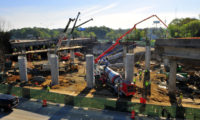
After 11 weeks of fast-track repairs, the Delaware Dept. of Transportation's emergency design and construction team reopened northbound lanes of the I-495 bridge in Wilmington on Aug. 23. The work allowed both sides of the 4,800-ft-long structure to be fully operational in time for the expected crush of Labor Day weekend traffic.
The 40-year-old concrete-deck-on-steel-beam bridge, which typically carries about 90,000 vehicles a day, was closed on June 2, when an inspection discovered four of its 37 support piers were as much as 4° out of vertical alignment. DelDOT believes a 50,000-ton mound of dirt stockpiled nearby created lateral subsurface pressure on the pilings, tilting the 50-ft hammerhead piers.
To stabilize and realign a 400-ft section of the bridge, DelDOT design consultant AECOM and contractor J.D. Eckman, Atglen, Pa., developed a strategy by which four temporary shoring towers were erected around each of the four piers to support a 6-ft by 8-ft header beam extending 134.5 ft beneath the entire superstructure as a temporary pier cap.
Six 100-ton jacks atop the beam lifted the superstructure about a quarter inch off the existing piers before the bearings were cut. Then, two 300-ton jacks were used to rebalance the superstructure.
Barry Benton, DelDOT's assistant director of bridges, says the efforts of the drilling subcontractors—R.E. Pierson Construction Co., Pilesgrove, N.J., and A.H. Beck Foundation Co., San Antonio, Texas—expedited drilling, on average, 150 ft to bedrock thirty-two 4-ft-dia support shafts for the towers' foundations.
"We didn't know how well they'd go in, given there was only 50 feet of clearance beneath the bridge, plus the underlying soil conditions," Benton says. "That they were able to vibrate them in, rather than have to use oscillation, helped."
The project team also gained time by using 50,000-lb rebar cages for the shafts, originally fabricated for the Tappan Zee Bridge project in New York City. "The normal lead time for cages like this would have been six weeks, but the contractor [Tappan Zee Constructors LLC] agreed to supply them," Benton says.
The cages were shipped in 40-ft sections, spliced on the ground and lifted in one piece. Crews cut holes in the bridge deck and lowered the 150-ft-long cage into the shaft in one piece.
The time savings also have helped DelDOT reduce its estimated costs to less than $35 million, including permanent repair work.
"The structure will use the existing shoring tower foundations, augmented with additional slab-on-grade beams," says J.D. Eckman Vice President Greg Burkhart. "We'll then jack up the superstructure and install new bearings."



























Post a comment to this article
Report Abusive Comment